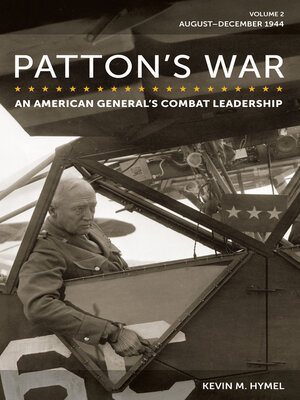Patton's War
ebook ∣ An American General's Combat Leadership, Volume 2: August–December 1944 · American Military Experience
By Kevin M. Hymel

Sign up to save your library
With an OverDrive account, you can save your favorite libraries for at-a-glance information about availability. Find out more about OverDrive accounts.
Find this title in Libby, the library reading app by OverDrive.



Search for a digital library with this title
Title found at these libraries:
| Library Name | Distance |
|---|---|
| Loading... |
Winner of the 2023 Army Historical Foundation Distinguished Writing Award for Biography
Finalist for the 2023 Gilder Lehrman Military History Prize
This second of three volumes of Patton's War picks up where the first one left off, examining General George S. Patton's leadership of the U.S. Third Army. The book follows Patton's contributions to both the Normandy and Brittany campaigns—the closing of the Falaise Pocket in Normandy, and racing to the port cities in Brittany. It ends with Patton and his corps rescuing the besieged town of Bastogne in the Battle of the Bulge.
As he did in the preceding volume, Hymel relies not only on Patton's diaries and letters, but countless veteran interviews, surveys, and memoirs. He also provides a unique insight missed by previous Patton scholars. Instead of using Patton's transcribed diaries, which were heavily edited and embellished, he consults Patton's original, hand-written diaries to uncover previously unknown information about the general.
This second volume of Hymel's groundbreaking work shows Patton at the height of his generalship, successfully leading his army without the mistakes and caustic behavior that almost got him sent home earlier—even if we also see a Patton still guided at times by racism and antisemitism.
Finalist for the 2023 Gilder Lehrman Military History Prize
This second of three volumes of Patton's War picks up where the first one left off, examining General George S. Patton's leadership of the U.S. Third Army. The book follows Patton's contributions to both the Normandy and Brittany campaigns—the closing of the Falaise Pocket in Normandy, and racing to the port cities in Brittany. It ends with Patton and his corps rescuing the besieged town of Bastogne in the Battle of the Bulge.
As he did in the preceding volume, Hymel relies not only on Patton's diaries and letters, but countless veteran interviews, surveys, and memoirs. He also provides a unique insight missed by previous Patton scholars. Instead of using Patton's transcribed diaries, which were heavily edited and embellished, he consults Patton's original, hand-written diaries to uncover previously unknown information about the general.
This second volume of Hymel's groundbreaking work shows Patton at the height of his generalship, successfully leading his army without the mistakes and caustic behavior that almost got him sent home earlier—even if we also see a Patton still guided at times by racism and antisemitism.







